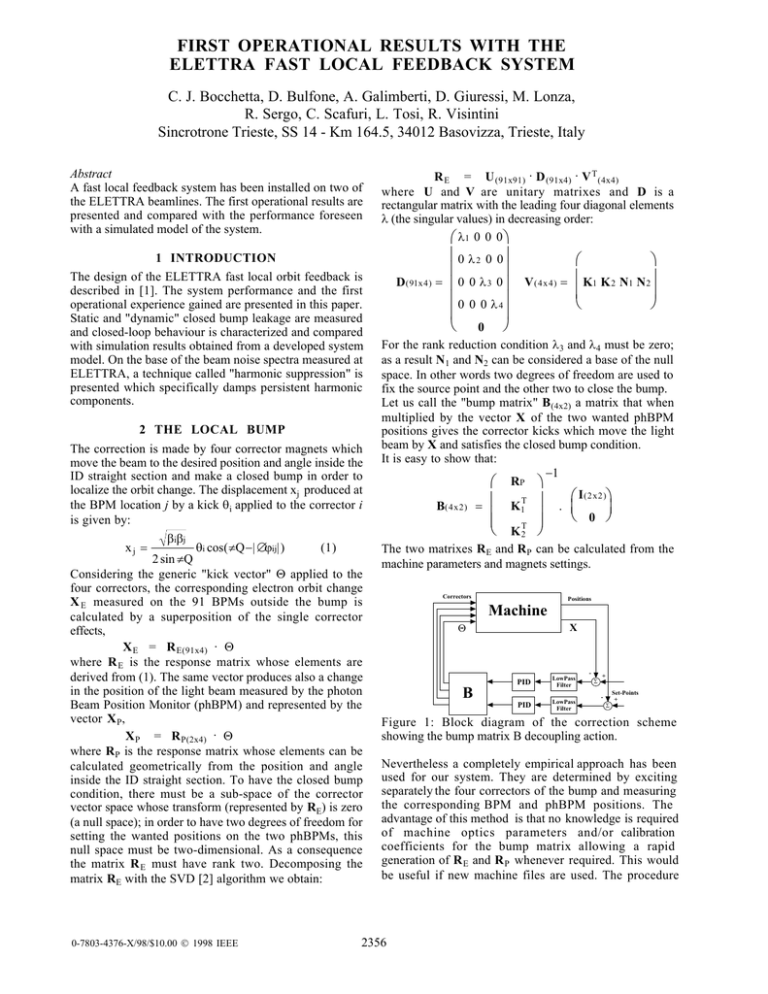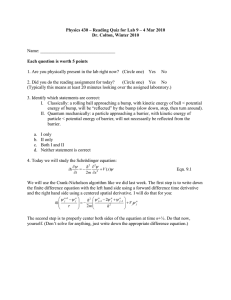2356
advertisement

FIRST OPERATIONAL RESULTS WITH THE ELETTRA FAST LOCAL FEEDBACK SYSTEM C. J. Bocchetta, D. Bulfone, A. Galimberti, D. Giuressi, M. Lonza, R. Sergo, C. Scafuri, L. Tosi, R. Visintini Sincrotrone Trieste, SS 14 - Km 164.5, 34012 Basovizza, Trieste, Italy Abstract A fast local feedback system has been installed on two of the ELETTRA beamlines. The first operational results are presented and compared with the performance foreseen with a simulated model of the system. 1 INTRODUCTION The design of the ELETTRA fast local orbit feedback is described in [1]. The system performance and the first operational experience gained are presented in this paper. Static and "dynamic" closed bump leakage are measured and closed-loop behaviour is characterized and compared with simulation results obtained from a developed system model. On the base of the beam noise spectra measured at ELETTRA, a technique called "harmonic suppression" is presented which specifically damps persistent harmonic components. 2 THE LOCAL BUMP The correction is made by four corrector magnets which move the beam to the desired position and angle inside the ID straight section and make a closed bump in order to localize the orbit change. The displacement xj produced at the BPM location j by a kick θi applied to the corrector i is given by: βiβj xj = θi cos(πQ−| ∆ϕij| ) (1) 2 sin πQ Considering the generic "kick vector" Θ applied to the four correctors, the corresponding electron orbit change X E measured on the 91 BPMs outside the bump is calculated by a superposition of the single corrector effects, X E = R E(91x4) . Θ where R E is the response matrix whose elements are derived from (1). The same vector produces also a change in the position of the light beam measured by the photon Beam Position Monitor (phBPM) and represented by the vector X P, X P = R P(2x4) . Θ where R P is the response matrix whose elements can be calculated geometrically from the position and angle inside the ID straight section. To have the closed bump condition, there must be a sub-space of the corrector vector space whose transform (represented by RE) is zero (a null space); in order to have two degrees of freedom for setting the wanted positions on the two phBPMs, this null space must be two-dimensional. As a consequence the matrix R E must have rank two. Decomposing the matrix RE with the SVD [2] algorithm we obtain: 0-7803-4376-X/98/$10.00 1998 IEEE R E = U (91x91) . D (91x4) . V T (4x4) where U and V are unitary matrixes and D is a rectangular matrix with the leading four diagonal elements λ (the singular values) in decreasing order: λ1 0 0 0 0 λ 2 0 0 D(91x 4) = 0 0 λ 3 0 0 0 0 λ 4 0 V ( 4x 4) = K1 K 2 N1 N 2 For the rank reduction condition λ3 and λ4 must be zero; as a result N1 and N2 can be considered a base of the null space. In other words two degrees of freedom are used to fix the source point and the other two to close the bump. Let us call the "bump matrix" B (4x2) a matrix that when multiplied by the vector X of the two wanted phBPM positions gives the corrector kicks which move the light beam by X and satisfies the closed bump condition. It is easy to show that: −1 RP I (2 x2) T B( 4x2) = K1 . 0 T K2 The two matrixes R E and R P can be calculated from the machine parameters and magnets settings. Correctors Positions Machine Θ X - PID LowPass Filter PID LowPass Filter B Σ + Σ Set-Points + Figure 1: Block diagram of the correction scheme showing the bump matrix B decoupling action. Nevertheless a completely empirical approach has been used for our system. They are determined by exciting separately the four correctors of the bump and measuring the corresponding BPM and phBPM positions. The advantage of this method is that no knowledge is required of machine optics parameters and/or calibration coefficients for the bump matrix allowing a rapid generation of R E and R P whenever required. This would be useful if new machine files are used. The procedure 2356 takes a few seconds for each beam-line and can be carried out after each injection. In order to improve the accuracy, this method can be modified by performing the calculation in two steps. In the first we measure only R E. Secondly the two column vectors N1 and N2 are used to set the correctors. Let's call nij the position variation measured by the phBPM j due to Ni; the bump matrix can be calculated as: log magnitude −40 −60 0 10 1 2 10 10 Feedback ACTIVE 0 log magnitude −1 n11 n 21 = N1 N 2 . n12 n 22 Two major advantages are associated with the second step of the method. As N 1 and N 2 impose closed bumps the other beamlines are not perturbed by the procedure which can be carried out during user operations at different ID gap values. Non linearities due to sextupoles outside the bump are avoided. The bump matrix transforms the fourinput (correctors) by two-output (phBPM) system into a two-by-two system with decoupled channels, where the control algorithm is independently applied (fig. 1). −20 −20 −40 −60 0 10 1 2 10 10 Hz Figure 2: 0-200 Hz noise spectra with loop open and closed (KP=3, KI=0.01, KD=10, fc=150 Hz). Closed-loop operation has also been optimized in the 0 - 40 Hz range (fig. 3). Feedback INACTIVE 0.12 magnitude (arb. units) B( 4x2) Feedback INACTIVE 0 3 FIRST OPERATIONS AND RESULTS The local orbit feedback has to stabilize the photon beam counteracting fast beam oscillations and slow beam drifts. When the feedback is running, slow corrections create an offset in the settings of the D/A converters which reduces the amount of AC dynamic range available for fast corrections. In order to compensate such effects the DC components of the D/A converters are periodically "discharged" and transferred to the "normal" DC settings of the corrector power supplies through the ELETTRA control system [3]. 0.1 0.08 0.06 0.04 0.02 0 0 5 10 15 20 25 30 35 40 30 35 40 Feedback ACTIVE magnitude (arb. units) 0.12 0.1 0.08 0.06 0.04 0.02 0 0 5 10 15 20 25 Hz Figure 3: 0-40 Hz noise spectra with loop open and closed (KP=10, KI=0.01, KD=0, fc=30 Hz). Preliminary tests with real matrices acquired from the machine confirmed the existence of the rank reduction condition; λ 3 and λ 4 are actually not zero because of machine non-linearities and measurement errors but are much smaller than λ 1 and λ 2 (e.g. λ 1 =3935, λ 2 =2304, λ3=6, λ4=5). To evaluate the leakage, i.e. the propagation of the closed bump error, the beam orbit has been measured before and after the application of a bump. The rms of the difference orbit outside the bump was about 1 µm, namely comparable with the resolution of the BPMs. A time domain measurement has been performed by perturbing the beam orbit with a square wave at 5 Hz generated by another DSP based system modulating the current of a corrector magnet not involved in the feedback. The results are shown in fig. 4. Feedback INACTIVE 0.04 0.02 mm 3.1 Static Leakage measurements 0 −0.02 −0.04 0 3.2 Closed Loop measurements 0.4 0.6 0.8 1 0.8 1 Feedback ACTIVE 0.04 0.02 mm The behaviour of the closed-loop on the machine is in good agreement with simulations [1]. Fig. 2 shows the measured spectra before and after closing the loop. The Proportional Integral Derivative (PID) [4] parameters (KP, KI, KD) as well as the low pass filter cut-off frequency f c have been empirically determined with the aid of the model to optimize the response in the range 0 - 200 Hz. Attenuation of about 9 dB of the 50 Hz component, 6 dB of the 100 Hz and 3 dB of the 150 Hz have been obtained and confirm the predictions given by simulation on the model. 0.2 0 −0.02 −0.04 0 0.2 0.4 0.6 s Figure 4: Open and closed-loop time domain measurements perturbing the beam with a 5 Hz square wave. 2357 One of the main goals of a local orbit feedback system is to decouple the activity of the different beamlines. Perturbations induced on a given beamline by a gap change of another insertion device must be eliminated. Fig. 5 shows the position acquired on the phBPM of the beamline 6 during a gap change of ID_3 without and with feedback on ID_6 (before the implementation of the improved insertion device compensation scheme [5]) . Feedback INACTIVE magnitude (arb. units) 2 Max gap mm −0.01 −0.02 200 250 300 350 mm −0.01 −0.02 100 150 80 100 120 140 160 180 200 140 160 180 200 1 0.5 20 40 60 80 100 120 Figure 6: Experiment closed-loop operation running a single harmonic suppressor centered at 50 Hz. 400 0 50 60 Hz Feedback ACTIVE −0.03 0 40 1.5 0 0 Min gap 150 20 Feedback ACTIVE magnitude (arb. units) Max gap 100 0.5 2 0 50 1 0 0 Feedback INACTIVE −0.03 0 50 Hz 1.5 200 250 300 350 s 400 Figure 5: Effect of changing the gap of ID_3 on beamline 6 without and with the feedback active on ID_6. 3.3 Dynamic Leakage measurements "Dynamic" leakage of the bump closure can drive instabilities when multiple active feedback loops are concurrently running on different beamlines. In order to evaluate the closed bump dynamic error of the feedback system, the photon beam position has been observed on the phBPM of another beamline. Signals before and after the closure of the loop have been recorded and analyzed, but no perceptible difference has been noticed. 4 THE HARMONIC SUPPRESSOR A newly implemented technique, called "harmonic suppression", has been applied to damp the 50 Hz component and its harmonics which can be clearly identified in the beam position spectrum acquired by the phBPM. It consists of a selective digital filter with programmable delay and gain centered at the frequency to damp. The delay is calculated in order to get a overall system open-loop rotation of 360° at the chosen frequency. Simulation results are very promising and show the possibility of implementing multiple harmonic suppressors centered at different frequencies together with a standard PID regulator for the non-periodic components. The first tests on the machine with a single harmonic suppressor (fig. 6) running on the DSP system have confirmed the simulations. Other tests with one harmonic suppressor associated to a PID regulator have been carried out with success. 5 CONCLUSIONS A fast local orbit feedback system has been developed and implemented on two of the ELETTRA beamlines. All additional beamlines will have the system installed by the end of this year. An empirical method has been developed for the generation of the bump matrix. Its application produces no perceptible leakage of the local correction. First closed-loop tests have been performed using a standard PID regulator and an attenuation bandwidth of 0150 Hz has been achieved. The results are in good agreement with the simulations. Persistent harmonic components of the beam noise have been effectively damped by dedicated harmonic suppressors. The concurrent utilization of the above techniques should provide the best way to counteract the beam noise spectra measured at ELETTRA. 6 ACKNOWLEDGEMENTS The authors would like to thank M. Vento and M. Zaccaria for their technical skill. [1] [2] [3] [4] [5] 2358 REFERENCES C. J. Bocchetta et al.: 'The Design of the ELETTRA Fast Local Feedback System', these Proceedings. G. H. Golub and C. Reinsch: 'Singular Value Decomposition and Least Squares Solutions', Numer. Math. 14, pp. 403-420, 1970. D. Bulfone: 'Status and Prospects of the ELETTRA Control System', Nucl. Instr. and Meth. A 352, p. 63, 1994. G. F. Franklin: 'Feedback Control of Dynamic Systems', Addison-Wesley Pub. Co., 1994. R. P. Walker et al.: 'Operation of Insertion Devices in ELETTRA and Plans for Future Devices', these proceedings.



